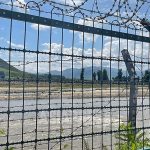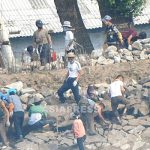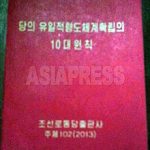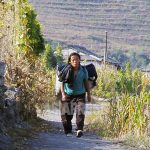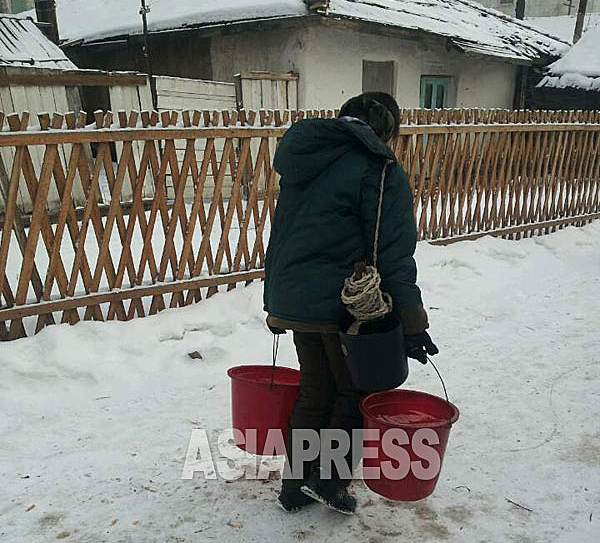
The weather in North Korea has grown colder since mid-December. The fate of people living in the northern region of the country – where temperatures frequently reach 20-30 Celsius below zero in the mornings and evenings – hangs on whether they can obtain fuel to cook and to heat their homes. In cities in North Hamgyong Province, workers have been given government rations of coal since last year; however, the amount they’ve been give is less than 1/3 of what they’ve received in years prior. People living in urban areas, meanwhile, are gathering in front of mines to gather what coal they can, sometimes forcing local police to come and disperse them. (KANG Ji-won)
◆ State distributions of coal don’t make up for shortfall
“Workers at factories and enterprises have been given 150 kilograms of coal per person for cooking and heating purposes”
On December 20, ASIAPRESS received this report from a reporting partner who works at a state-run enterprise in an urban area of North Hamgyong Province.
Just as it was last year, it is rare for the authorities to conduct a widespread distribution of coal to workers. Coal is being sold at the inexpensive state-set price established a long time ago; moreover, the costs of the coal are taken out of laborers’ wages. How, then, do the country’s factories and enterprises raise the funds to pay for the coal?
Presently, none of North Korea’s factories and enterprises can pay for the coal. The wages paid out by state-run companies are little more than formalities, typically ranging from 2,000 to 5,000 North Korean won (around 310-776 South Korean won). It is also true that workers are having a difficult time earning money via business activities due to the country’s economic malaise, largely due to the regime’s COVID-19 prevention efforts.
To ordinary North Koreans, obtaining firewood and coal for the winter is a matter of life and death. ASIAPRESS’s reporting partner said that “the difficulties of the people were reported to the leadership, leading them to distribute coal through jeonpyo (deposit slips).” The way it works is as follows:
The state issues “coal jeonpyo” to state-run companies that guarantees payment of the costs, and the companies use the jeonpyo for the transfer of coal from the coal mines. Coal companies then submit these jeonpyo to banks and government agencies and are paid at a later date. In January of last year, this “coal jeonpyo” system was used to provide laborers with 500-800 kilograms of coal per person. Then, as now, it was rare for the North Korean authorities to use this system to distribute coal.
◆ People can’t survive the winter with just 150 kilograms of coal
Transactions using jeonpyo, however, involve just the transport of coal from within the mines. From there, state-run companies must use their own resources to transport the coal to their workplaces. Ultimately, the costs involved in hiring vehicles and pay for their fuel can’t be paid for through the coal received, meaning that the amount of coal workers receive is much less than 150 kilograms per person.
Moreover, the distributions of coal are only for laborers who go to work. Coal for their family members, or for elderly retired people, must be paid for with cash.
According to a defector from North Hamgyong Province, each household needs 1.5 to 2 tons of coal each winter for cooking and heating purposes. ASIAPRESS’s reporting partner said angrily that the amount of coal available is much less than what’s needed.
“The harvest season has finished, but food prices haven’t fallen much, and everybody lacks money, so life is really tough. What’s more, we all are worried about freezing to death. How can we survive the winter with just 150 kilograms of coal?”
◆ The young and old gather at coal mines to pick up what coal they can
That being said, the market price of coal has fallen dramatically following the recent coal distributions. According to the reporting partner, one ton of coal – which used to cost about 130 yuan – now costs just 95 yuan. There are so many people in poverty, however, that many are bartering food for coal near coal mines.
※ One yuan is equal to 184 South Korean won
The reporting partner gave some context to the chaos reigning on the ground:
“Lots of people, from children to elderly people, are gathering in front of mines to grab what coal they can. An enforcer unit with the Obong Mine in Eundok County cracked down on a group of people gathered there and confiscated all the coal they had gathered for themselves. There were people crying in frustration about their poverty-stricken lives, and the local police were even called because a knife fight broke out.”
※ ASIAPRESS smuggles Chinese cellphones into North Korea to maintain communication with its reporting partners.
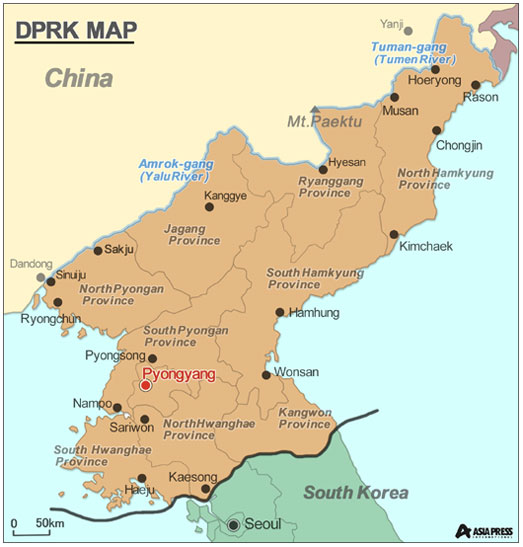
- <Inside N. Korea> The Kim regime shifts its food policy, suppressing food sales in markets while creating a state monopoly on the food supply ISHIMARU Jiro
- <Inside N. Korea> Two N. Koreans caught attempting to defect arrested and possibly executed by firing squad…Government says “defections will not be forgiven”
- <Interview with Two N. Korean Women> How do N. Koreans view the appearance of Kim Jong-un’s daughter, “Ju-ae”? Rumors circulate that she’s a “genius” and an “advisor” to her father
- <Inside N. Korea>RMB-KRW exchange rate sees unprecedented rise, 36% higher than 3 weeks ago…“Foreign currency has dried up now”
- Human rights situation has only worsened during Kim Jong-un’s 11 years in power ISHIMARU Jiro

